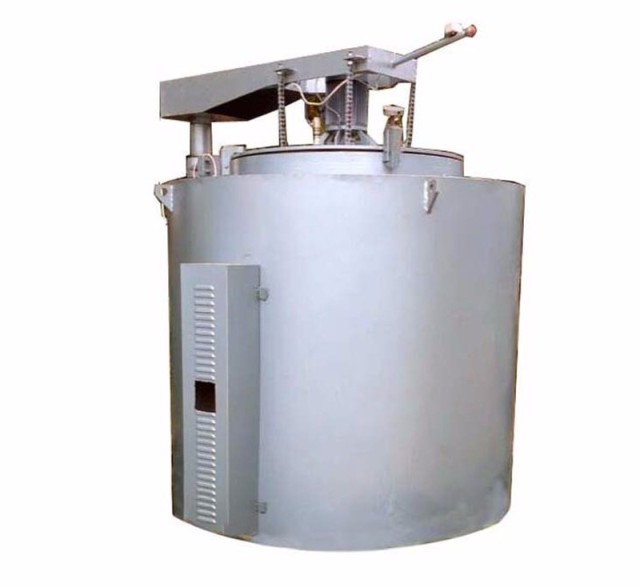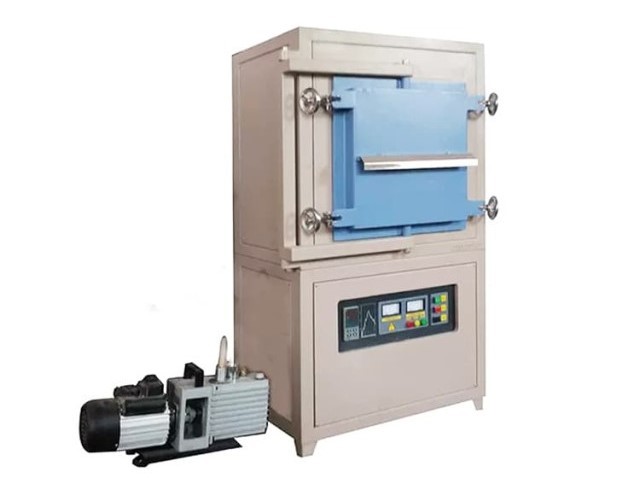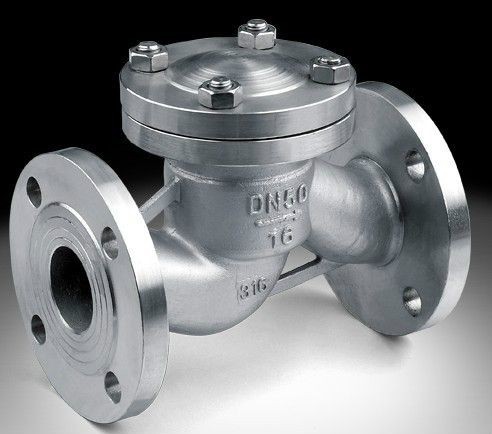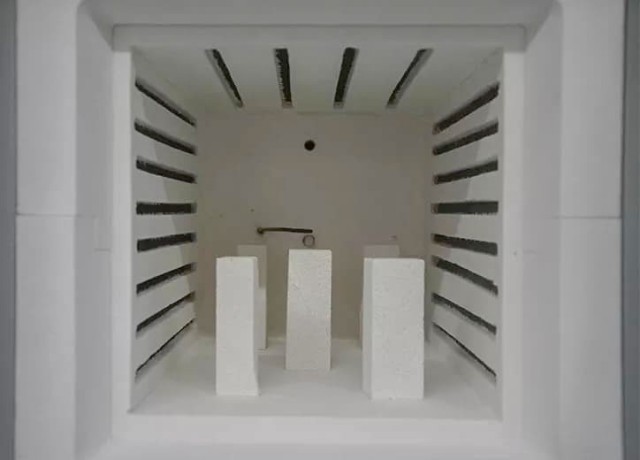Classification of Controlled Atmosphere Heat Treatment Furnace
Periodic Furnace
Periodic furnaces, including pit-type and sealed box furnaces, are designed for small batch production. These furnaces are versatile, capable of performing a range of heat treatment processes such as bright quenching, bright annealing, carburizing, and carbon-nitrogen co-penetration. The sealed box furnace, also known as a multi-purpose furnace, is particularly noted for its adaptability and efficiency in handling various materials and components.
In small batch production scenarios, periodic furnaces offer a controlled environment that ensures the quality and consistency of the treated materials. The pit-type furnace, with its deep, cylindrical design, provides a stable and uniform heat distribution, making it ideal for processes requiring precise temperature control. On the other hand, the sealed box furnace excels in maintaining a protective atmosphere, which is crucial for preventing oxidation and decarburization during heat treatment.
Both types of periodic furnaces are equipped with features that enhance their functionality and safety. These include robust sealing mechanisms to maintain the integrity of the controlled atmosphere, as well as advanced temperature control systems to ensure uniform heating. The periodic nature of these furnaces allows for flexibility in production schedules, making them suitable for industries where custom or small-scale orders are common.

Continuous Furnace
Continuous furnaces are industrial heat treatment systems designed for high-volume production, offering a continuous and uninterrupted flow of workpieces through the heating chamber. Unlike batch furnaces, which process a limited number of workpieces at a time, continuous furnaces are engineered to handle a steady stream of materials, making them ideal for mass production environments.
These furnaces are equipped with various mechanisms to ensure a smooth and continuous movement of workpieces. Common systems include conveyor belts, 'walking beams', rotary screws, and other automated means of transporting parts through the furnace. While manual loading and unloading can still occur, the process time is typically measured in minutes rather than hours, emphasizing their efficiency in high-production settings.
The continuous nature of these furnaces allows for consistent heat treatment processes, such as bright quenching, tempering, carburizing, and carbonitriding. The furnace's heating elements generate the necessary heat, while the conveyor or roller system ensures that workpieces move steadily through the heating chamber, undergoing the specified treatment as they progress. This continuous flow not only enhances productivity but also ensures uniformity in the treatment process, leading to consistent product quality.
Characteristics of Controlled Atmosphere Heat Treatment Furnace
Good Sealing of the Furnace Chamber
Effective sealing of the furnace chamber is crucial for maintaining the integrity and efficiency of the controlled atmosphere heat treatment process. This involves sealing multiple critical components, including the furnace body, doors, electric heating element lead holes, thermocouple holes, fan shaft holes, and push-out mechanical holes. Each of these components must be meticulously sealed to prevent any leakage of the controlled atmosphere, which could compromise the treatment process.
The furnace body typically employs continuous welds to ensure a tight seal, while removable components like the door gaskets are often made from materials such as asbestos rope and water glass. These gaskets are compressed using screws to create a tight seal. Additionally, specialized sealing fillers, compression flanges, oil seals, and water cooling methods are used to further enhance the seal around various furnace openings.
For the furnace doors, a dual-door system is often employed, where the front and back rooms of the material are separated by two doors that alternately open and close. This design prevents uncontrolled air from entering the furnace directly. The doors themselves are equipped with sand sealing grooves, rollers, and oblique blocks that, when combined with the door bolts, create a gravity-assisted seal. Some designs also incorporate fire shade seals for added security.
Electric heating elements, which are critical for maintaining the desired temperature within the furnace, require materials or coatings that are resistant to carburization. These elements are often powered by low-pressure systems to ensure their longevity and effectiveness.
Regular leak detection is also an essential practice to maintain the integrity of the furnace's sealing system. This involves periodic checks of the piping system to identify and address any potential leaks promptly. By ensuring a good seal, the furnace can maintain a stable and controlled atmosphere, which is vital for the successful heat treatment of materials.
Furnace Maintaining Positive Pressure
Maintaining positive pressure within the furnace is crucial for preventing explosions and ensuring a stable atmosphere. This is achieved through a combination of sophisticated mechanisms designed to control the internal environment meticulously. The primary measures include the precise regulation of gas input, which is often managed through automated systems that monitor and adjust gas flow rates in real-time. Additionally, water seals are employed to create a barrier that prevents the escape of gases, thereby maintaining the desired pressure levels.
Pressure control systems are integrated into the furnace design to continuously monitor and adjust the internal pressure, ensuring it remains above atmospheric pressure. This is particularly important in environments where the controlled atmosphere is a mixture of gases that could be hazardous if leaked. Charging chambers are another critical component, designed to introduce materials into the furnace without disrupting the internal pressure. These chambers are equipped with mechanisms that allow for controlled entry and exit, minimizing pressure fluctuations.
Fire curtain devices are also utilized to isolate different sections of the furnace, providing an additional layer of safety and control. These devices can quickly deploy to seal off areas where pressure or gas composition needs to be maintained independently. Together, these measures create a robust system that ensures the furnace operates safely and efficiently, maintaining the integrity of the controlled atmosphere necessary for the heat treatment process.

Uniform Atmosphere in the Furnace
Ensuring a uniform atmosphere within the furnace is crucial for maintaining consistent product quality during heat treatment processes. This uniformity is achieved through the strategic circulation of the controlled atmosphere, which is facilitated by the integration of fans within most modern furnaces. These fans play a pivotal role in distributing the atmosphere evenly throughout the heating chamber, thereby preventing any localized variations that could affect the treatment outcome.
The atmosphere is typically supplied from either the side or above the heating chamber, depending on the specific design and operational requirements of the furnace. This methodical distribution ensures that every part of the product is exposed to the same environmental conditions, thereby guaranteeing uniformity in the heat treatment process. Such precision is essential for applications where even a slight deviation in the atmosphere could lead to significant variations in the final product's properties.
In addition to the fans, the design of the furnace also plays a critical role in maintaining this uniformity. The layout of the heating elements, the configuration of the air intake and exhaust systems, and the overall construction of the furnace all contribute to the effective circulation of the controlled atmosphere. This holistic approach ensures that the furnace operates efficiently and reliably, delivering high-quality results consistently.
Installation of Safety Devices
The installation of safety devices in controlled atmosphere heat treatment furnaces is paramount due to the inherent toxicity and explosion risks associated with the controlled atmosphere. These devices are meticulously designed to mitigate potential hazards and ensure operational safety. The primary safety devices include:
-
: These prevent the backflow of gases, ensuring that the controlled atmosphere remains within the designated areas and does not contaminate other sections of the facility.
-
Shut-Off Valves: These are critical for emergency situations, allowing for the rapid isolation of gas supply lines to prevent further leakage or contamination.
-
Flame Check Valves: These are installed to detect and extinguish any flames that may inadvertently form within the furnace, thereby preventing potential explosions.
-
Pressure Gauges: These provide real-time monitoring of the internal pressure within the furnace, ensuring it remains within safe operational limits.
-
Safety Alarms: These are triggered by abnormal conditions, such as excessive pressure or temperature deviations, alerting operators to take immediate corrective actions.
-
Explosion-Proof Holes: These are strategically placed to safely vent any buildup of pressure in the event of an explosion, minimizing damage to the furnace and surrounding areas.
The integration of these safety devices is essential for maintaining a secure working environment and ensuring the longevity and reliability of the controlled atmosphere heat treatment process.

Furnace Components Anti-Atmosphere Erosion
To ensure the longevity and efficiency of a controlled atmosphere heat treatment furnace, the furnace lining must be constructed using impermeable brick masonry. This impermeability is crucial as it prevents the controlled atmosphere from escaping, thereby maintaining the integrity of the heating process and the quality of the treated materials.
Electric heating elements, which are integral to the operation of the furnace, face significant risks of erosion due to the harsh environments they operate in. To mitigate this risk, these elements are often protected through the use of radiation tubes or by heating in an oxidizing atmosphere. Radiation tubes act as a barrier, shielding the heating elements from direct contact with the controlled atmosphere, which can contain corrosive gases. Alternatively, heating in an oxidizing atmosphere can create a protective layer on the surface of the heating elements, reducing their exposure to the corrosive effects of the controlled atmosphere.
By employing these protective measures, the service life of the electric heating elements is significantly extended, ensuring the continuous and reliable operation of the furnace.
Related Products
- 1400℃ Controlled Atmosphere Furnace with Nitrogen and Inert Atmosphere
- 1200℃ Controlled Atmosphere Furnace Nitrogen Inert Atmosphere Furnace
- Mesh belt controlled atmosphere furnace
- 1700℃ Controlled Atmosphere Furnace Nitrogen Inert Atmosphere Furnace
- Controlled Nitrogen Inert Hydrogen Atmosphere Furnace
Related Articles
- Exploring Tungsten Vacuum Furnaces: Operation, Applications, and Advantages
- Controlled Atmosphere Furnace: Comprehensive Guide to Advanced Heat Treatment
- Atmosphere Furnaces: Comprehensive Guide to Controlled Heat Treatment
- Comprehensive Guide to Atmosphere Furnaces: Types, Applications, and Benefits
- Muffle Furnace: Unraveling the Secrets of Uniform Heating and Controlled Atmosphere




















